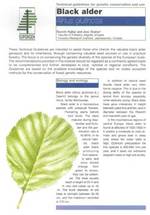Alnus glutinosa - Technical guidelines for genetic conservation and use for black alder
This publication has been translated into the following languages:
Italian Polish Slovenian
Black alder can not be naturally regenerated as other broadleaved forest tree species. Following fertilization, there is a 30 day seed period, followed by a further 30 days as cotyledons. The supply of nutrients during this germination period is critical as well as sufficient moisture and light, to ensure the development of the leaves and stem. In natural stands of black alder these conditions are almost impossible due to weed vegetation and old tree canopies. The natural regeneration of black alder is successful when the humus layer of the soil is removed to promote germination.
To generate progeny from a natural population to be genetically equivalent that from natural regeneration, several conditions must be met: the felling of mature trees in a given stand must coincide with seed ripeness; seeds must be sampled from 10-50 diverse trees on every 30-40 ha of area, and good quality seedlings should be planted on a prepared site (3000- 4500 plants/ha).
The ex situ conservation of black alder genetic resources should be undertaken using seedling or clonal seed orchards. Since black alder reaches regenerative maturity relatively early, seedling seed orchards can be used if seeds are sampled from 200-300 trees throughout all natural populations (which represent one seed unit or ecological race). For the establishment of clonal seed orchards it is necessary to select about 100 normal (typical) and plus trees from one seed zone or region. In this way the clonal seed orchard established would represent a “breeding population”, and could be used for conservation as well as for breeding purposes.
Authors: Davorin Kajba; Joso Gračan
Corporate Author: European Forest Genetic Resources Programme; International Plant Genetic Resources Instit., Rome (Italy)
Journal/Series:
EUFORGEN Technical Guidelines for Genetic Conservation and Use
Publication Year: 2003
Publication Format: Folder; PDF
ISBN: 92-9043-566-6
ISBN 13: 978-92-9043-566-2
Language: EN
Pages: 4 p.
Technical guidelines Alnus glutinosa

